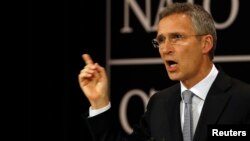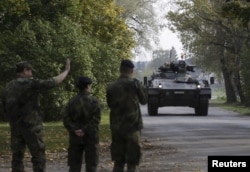A meeting Wednesday of NATO and Russian ministers, billed as an opportunity to defuse tensions after the alliance's recent declaration that it was in deterrence mode on Russia, produced no "meeting of the minds,” NATO's chief said.
The NATO-Russia Council, set up 14 years ago to help avert crises, met in Brussels following last week's NATO summit in Warsaw, where the alliance announced it was deploying four battalions along its eastern flank in the face of Russia's more assertive, more aggressive behavior. Russia is not happy about the NATO buildup in nations that have historically been under its control, and analysts expected those tensions to dominate Wednesday's meeting.
They did.
“It was a useful meeting with frank and open discussions,” NATO Secretary General Jens Stoltenberg said after Wednesday's meeting. He said Ukraine topped the agenda.
“NATO allies do not and will not recognize Russia’s illegal and illegitimate annexation of Crimea,” Stoltenberg told reporters.
Rare session
The meeting of the council was only the second since 2014, when NATO suspended all practical civilian and military cooperation with Russia after Russian-backed forces seized parts of eastern Ukraine and Moscow annexed the Crimean Peninsula. Prior to that, the council had suspended formal meetings following Russia’s invasion of Georgia in 2008. NATO said it continues to call on Russia to reverse its decision to recognize the Georgian breakaway regions of Abkhazia and South Ossetia as independent states.
With cooperation suspended, analysts expected little progress in resolving the impasse between Russia and NATO, but the meeting was crucial since it followed what Moscow views as a dramatic and provocative change in the alliance’s posture. Russia’s representative at NATO called the measures “excessive.”
“I would expect them to fume. I would expect a lot of angry rhetoric out of Moscow,” David Shlapak, a defense analyst at the RAND Corporation, told VOA.
Analysts said the decision by the United States and NATO to boost the alliance’s presence in the Baltic States and Poland was necessary as Russia builds up its forces to dangerous levels, putting NATO members Estonia and Latvia in a potentially vulnerable position.
War games conducted by RAND show Russian forces could currently deploy to the outskirts of the Estonian capital, Tallinn, or the Latvian capital, Riga, within 60 hours. Shlapak, who advised U.S. officials on their current Russian strategy, said NATO has very few forces postured in the region and their ability to move tanks, armored personnel carriers and heavy artillery into the region on short notice is very limited. Russia, he said, has a strong edge.
“It turns into a fight of steel on the Russian side against flesh on the NATO side, and that’s a very one-sided battle,” Shlapak said.
Call for transparency
While there was little evidence that tensions were eased in Brussels on Wednesday, there was a call for both sides to play by the rules.
“Everyone around the table today has a responsibility to ensure that our relations are characterized by predictability, confidence and stability,” Stoltenberg said, while urging Russia to behave in a transparent manner. "Transparency and risk reduction is particularly important if we are to avoid incidents, accidents and misunderstandings.”
Seeking to ease tensions after a series of near misses, Russia proposed steps to reduce the risk of air collisions. Stoltenberg welcomed the gesture as something the alliance has been advocating for a long time and said the alliance would study the proposal carefully.
U.S. officials and analysts deny any suggestion that the tensions, NATO’s new buildup and the new deterrence posture signal the start of a new Cold War. But signs of any warming remain elusive.








